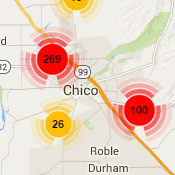What is a Home Inspection?
A home Inspection is a on-site report that combines a checklist & narrative with photos. All home inspections are different and can vary dramatically from state to state, as well as across counties and cities. Much depends on the home inspector and which association, if any, to which the home inspector belongs. The National Association of Certified Home Inspectors or NACHI guidelines are the most common "inspection standards".Home Inspection Checklist of Items Not Inspected
Understand that California home inspectors are not licensed, nor are they licensed in many states. However, a home inspector's standard practice typically does not include the following, for which a specific license to inspect and identify is required:
- Asbestos
- Radon, Methane, Radiation and Formaldehyde
- Wood-Destroying Organisms
- Mold, Mildew and Fungi
- Rodents
- Lead
- Structural Elements. Construction of walls, ceilings, floors, roof and foundation.
- Exterior Evaluation. Wall covering, landscaping, grading, elevation, drainage, driveways, fences, sidewalks, fascia, trim, doors, windows, lights and exterior receptacles.
- Roof and Attic. Framing, ventilation, type of roof construction, flashing and gutters. It does not include a guarantee of roof condition nor a roof certification.
- Plumbing. Identification of pipe materials used for potable, drain, waste and vent pipes. including condition. Toilets, showers, sinks, faucets and traps. It does not include a sewer inspection.
- Systems and Components. Water heaters, furnaces, air conditioning, duct work, chimney, fireplace and sprinklers.
- Electrical. Main panel, circuit breakers, types of wiring, grounding, exhaust fans, receptacles, ceiling fans and light fixtures.
- Appliances. Dishwasher, range and oven, built-in microwaves, garbage disposal and, yes, even smoke detectors.
- Garage. Slab, walls, ceiling, vents, entry, firewall, garage door, openers, lights, receptacles, exterior, windows and roof.
- Health and safety issues
- Roofs with a short life expectancy
- Furnace / A/C malfunctions
- Foundation deficiencies
- Moisture / drainage issues
If you have a choice, it is smarter to hire your own contractors and supervise repairs. Before issuing a formal request to repair, consider the seller's incentive to hire the cheapest contractor and to replace appliances with the least expensive brands.
Although home inspectors are reluctant to and, in many cases, refuse to disclose repair costs, call a contractor to determine the scope and expense to fix minor problems yourself. No home is perfect. Every home will have issues on a home inspection. Even new homes.
A repair issue that will be be a deal breaker for a first-time home buyer, causing the buyer to cancel the contract, will not faze a home buyer versed in home repair. Talk to your agent, family, friends and call a few contractors to discuss which types of defects are minor. Perhaps a simple solution is available such as replacing a $1.99 receptacle, which can resolve many outlet problems.
Pat yourself on the back, too, for getting a home inspection. Some buyers feel a home inspection is unnecessary, especially if they are buying new construction. If a light switch doesn't work or the air conditioner blows out hot air, those are problems you can see and test. The problems that aren't readily identifiable to you such as code violations, a furnace that leaks carbon monoxide or a failing chimney, are the types of defects a home inspector could identify in a new home. Builders' contractors make mistakes, too.



